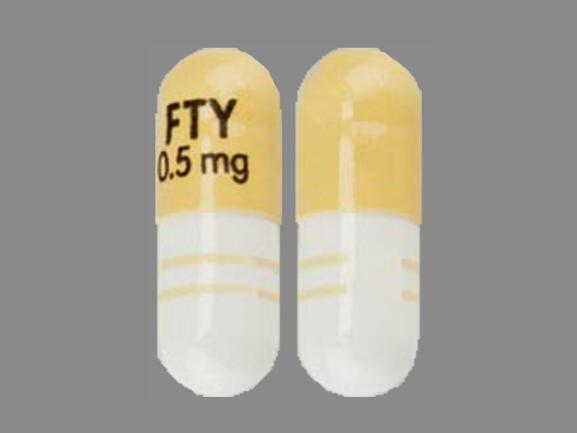Gilenya Dosage
Generic name: FINGOLIMOD HYDROCHLORIDE 0.5mg
Dosage form: capsule
Drug class: Selective immunosuppressants
Medically reviewed by Drugs.com. Last updated on Jan 31, 2024.
2.1 Assessment Prior to Initiating GILENYA
Cardiac Evaluation
Obtain a cardiac evaluation in patients with certain preexisting conditions [see Warnings and Precautions (5.1)].
Prior to starting treatment, determine whether patients are taking drugs that could slow heart rate or atrioventricular (AV) conduction [see Dosage and Administration (2.4), Drug Interactions (7.5)].
Complete Blood Count (CBC)
Review results of a recent CBC [see Warnings and Precautions (5.2), Drug Interactions (7.6)].
Serum Transaminases (ALT and AST) and Total Bilirubin Levels
Prior to starting treatment with GILENYA (i.e., within 6 months), obtain serum transaminases [alanine transaminase (ALT) and aspartate transferase (AST)] and total bilirubin levels [see Warnings and Precautions (5.5)].
Prior Medications
If patients are taking antineoplastic, immunosuppressive, or immune-modulating therapies, or if there is a history of prior use of these drugs, consider possible unintended additive immunosuppressive effects before initiating treatment with GILENYA [see Warnings and Precautions (5.2), Drug Interactions (7.4)].
Vaccinations
Test patients for antibodies to varicella zoster virus (VZV) before initiating GILENYA; VZV vaccination of antibody-negative patients is recommended prior to commencing treatment with GILENYA [see Warnings and Precautions (5.2)]. It is recommended that pediatric patients if possible, complete all immunizations in accordance with current immunization guidelines prior to initiating GILENYA therapy.
2.2 Important Administration Instructions
Patients who initiate GILENYA, and those who reinitiate treatment after discontinuation for longer than 14 days, require first-dose monitoring. This monitoring is also recommended when the dose is increased in pediatric patients [see Dosage and Administration (2.4, 2.5)].
GILENYA can be taken with or without food.
2.3 Recommended Dosage
In adults and pediatric patients 10 years of age and older weighing more than 40 kg, the recommended dosage of GILENYA is 0.5 mg orally once-daily.
In pediatric patients 10 years of age and older weighing less than or equal to 40 kg, the recommended dosage of GILENYA is 0.25 mg orally once daily.
Fingolimod doses higher than 0.5 mg are associated with a greater incidence of adverse reactions without additional benefit.
2.4 First-Dose Monitoring
Initiation of GILENYA treatment results in a decrease in heart rate, for which monitoring is recommended [see Warnings and Precautions (5.1), Clinical Pharmacology (12.2)]. Prior to dosing and at the end of the observation period, obtain an electrocardiogram (ECG) in all patients.
First 6-Hour Monitoring
Administer the first dose of GILENYA in a setting in which resources to appropriately manage symptomatic bradycardia are available. Monitor all patients for 6 hours after the first dose for signs and symptoms of bradycardia with hourly pulse and blood pressure measurement.
Additional Monitoring After 6-Hour Monitoring
Continue monitoring until the abnormality resolves if any of the following is present (even in the absence of symptoms) after 6 hours:
- the heart rate 6 hours postdose is less than 45 beats per minute (bpm) in adults, less than 55 bpm in pediatric patients 12 years of age and older, or less than 60 bpm in pediatric patients 10 or 11 years of age;
- the heart rate 6 hours postdose is at the lowest value postdose suggesting that the maximum pharmacodynamic effect on the heart may not have occurred;
- the ECG 6 hours postdose shows new onset second degree or higher atrioventricular (AV) block.
If postdose symptomatic bradycardia occurs, initiate appropriate management, begin continuous ECG monitoring, and continue monitoring until the symptoms have resolved if no pharmacological treatment is required. If pharmacological treatment is required, continue monitoring overnight and repeat 6-hour monitoring after the second dose.
Overnight Monitoring
Continuous overnight ECG monitoring in a medical facility should be instituted:
- in patients that require pharmacologic intervention for symptomatic bradycardia. In these patients, the first-dose monitoring strategy should be repeated after the second dose of GILENYA;
- in patients with some preexisting heart and cerebrovascular conditions [see Warnings and Precautions (5.1)];
- in patients with a prolonged QTc interval before dosing or during 6-hour observation, or at additional risk for QT prolongation, or on concurrent therapy with QT prolonging drugs with a known risk of torsades de pointes [see Warnings and Precautions (5.1), Drug Interactions (7.1)];
- in patients receiving concurrent therapy with drugs that slow heart rate or AV conduction [see Drug Interactions (7.5)].
2.5 Monitoring After Reinitiation of Therapy Following Discontinuation
When restarting GILENYA after discontinuation for more than 14 days after the first month of treatment, perform first-dose monitoring, because effects on heart rate and AV conduction may recur on reintroduction of GILENYA treatment [see Dosage and Administration (2.4)]. The same precautions (first-dose monitoring) as for initial dosing are applicable. Within the first 2 weeks of treatment, first-dose procedures are recommended after interruption of 1 day or more; during Weeks 3 and 4 of treatment, first-dose procedures are recommended after treatment interruption of more than 7 days.
Frequently asked questions
- Gilenya vs Tecfidera. How do they compare?
- Can Gilenya cause weight gain?
- Can Gilenya cause high blood pressure?
- Gilenya and the covid-19 vaccine, what should I know?
- Can Gilenya cause headaches?
- What are the new drugs used for multiple sclerosis (MS)?
- How much does Gilenya cost?
- What happens when you stop taking Gilenya?
- Does Gilenya suppress the immune system?
More about Gilenya (fingolimod)
- Check interactions
- Compare alternatives
- Pricing & coupons
- Reviews (95)
- Drug images
- Side effects
- Patient tips
- During pregnancy
- Generic availability
- Support group
- FDA approval history
- Drug class: selective immunosuppressants
- Breastfeeding
- En español
Patient resources
Other brands
Professional resources
Other brands
Related treatment guides
Further information
Always consult your healthcare provider to ensure the information displayed on this page applies to your personal circumstances.


